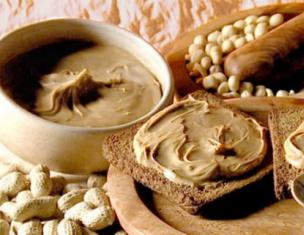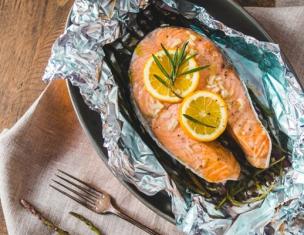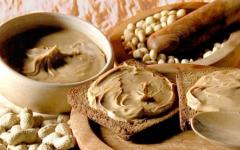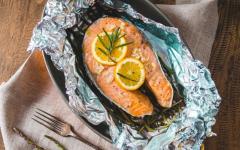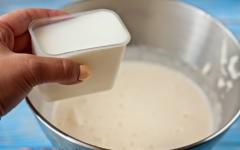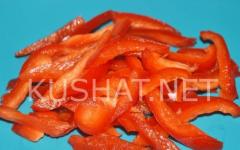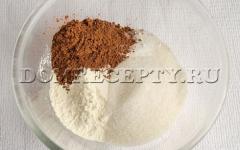When you watch American films, do you ever pay attention to what the characters eat for breakfast? With what pleasure do they spread peanut butter on toast, washing it all down with orange juice? Surely, some people noticed such moments and wanted to try the same simple, tasty and beautiful breakfast. If you want, why not? Bread for toast, like orange juice, is available in any store, and peanut butter is very easy to prepare at home. If you are inspired, then hurry up to the kitchen to create and experiment!
A little about peanut butter
For Americans, peanut butter is one of the most familiar foods in the diet. According to statistics, US residents eat about 300 million kg of it per year! Moreover, a third of this number is for breakfast. However, for residents of Russia and the CIS, such a product is a very exotic phenomenon. What is it?
Essentially, these are peanuts ground until smooth. The dish has a rather specific taste - a homogeneous dense buttery puree with the taste of nuts. Many say that it took them a while to get used to it. However, over time, the taste ceases to seem so strange, and you can fully experience the beauty of this product.
There are also sweet varieties of this dish for those who have not been able to fall in love with the classic version. As a rule, honey, chocolate or some sweet syrups, like maple, are added there.
Most often, as already mentioned, this “cream” is consumed for breakfast, spread on toast. However, there are also many recipes for various baked goods with the addition of this product: it helps create the desired consistency and adds notes of nutty flavor to finished dishes.

Calorie content. Benefits and harms
Peanut butter is a rather controversial product regarding its benefits for the body.
- On the one hand, it is rich in all kinds of vitamins, minerals and trace elements. It contains vitamins B, E, C, D, calcium, phosphorus, iron, etc. It also contains a large amount of unsaturated fatty acids, which are so necessary for the body. Regular consumption of this product helps maintain healthy blood cholesterol levels, normal liver function, nervous system, etc. In addition, the benefit of peanut butter lies in its satiety: no wonder Americans love it so much for breakfast! This dish contains high-quality proteins and fats, which allow you to remain alert and full for several more hours.
- However, the paste also has some negative properties. First of all, of course, its high calorie content. There are about 550 calories per 100 g of product. Excessive consumption of this product can lead to severe weight gain or even obesity. Therefore, you should consume no more than 3-4 tablespoons of peanut butter per day, and then it will bring only benefits and not harm.

Store-bought or homemade?
Why is it better to make peanut butter at home rather than buy it at the store?
- Firstly, as mentioned above, this product is not so popular in Russia and the CIS countries that you can easily buy it in every grocery store. Of course, it is available in many large hypermarkets and specialty stores, but then you will have to work hard to find it.
- Secondly, the price of the purchased product is unreasonably high. Peanut butter at home will cost you about three times less than store-bought.
- Thirdly, like almost any purchased product, this one does not always have a good composition. While homemade peanut butter only contains peanuts and a little oil (and even then optional), store-bought labels contain sugar, large amounts of unknown oil, stabilizers, dyes, etc.
- Well, fourthly, by making peanut butter at home, you put a piece of your love and care into it, so it will be doubly enjoyable to eat.

As you can see, making your own peanut butter has a lot of advantages. So keep reading the article to learn how to make peanut butter at home!
Homemade Peanut Butter Recipe
So, it's time to talk about how to make your own peanut butter after you have received so much information about it.
The composition of the dish is very simple, as is the process of its preparation. The only thing you need to master this peanut butter recipe at home is time and patience. Ready? Then let's get started!
Required ingredients:
- Peanuts (fresh, unsalted) – 0.5 kg;
- Sunflower oil (optional) – 1-2 tbsp. l;
- Salt – 1 pinch;
- Honey/chocolate (for sweet option) – 60 g.

Step-by-step instructions for making homemade peanut butter:
- First of all, roast the peanuts. This should be done in a dry frying pan, without oil. Make sure it doesn't burn - stir continuously. Frying takes about 7 minutes: you want the nuts to golden. You can read our article about.
- Now you need to peel it - this is one of the longest and most tedious processes in the entire peanut butter recipe. Let the peanuts cool completely to make the skins easier to remove and to avoid burning your fingers;
- Once the “nuts” are cleaned, put them in a good, powerful blender. Next, the scheme is simple: grind the “nuts” until they form a thick, soft, crumb-free substance, as in the photo. This will take quite a long time: the process may take about 20 minutes of continuous grinding. At first, the nuts will simply turn into fine crumbs. For a while it will even seem like you are doing something wrong, because in the crumb state they will last quite a long time. But don't panic! After some time, the peanuts will begin to release oil and acquire the desired creamy consistency. If it really doesn’t work out or you want to achieve even greater uniformity, you can add a couple of tablespoons of sunflower oil (others will give a specific taste);
- About halfway through the process, add a pinch of salt;
- If you want to make a sweet version, also add a few spoons of honey, syrup or chocolate chips into the blender;
- The dish gets an interesting taste if you add a few crushed pieces of peanuts to it so that they come across during eating and crunch on your teeth.

This is the kind of peanut butter we made at home. This very interesting, healthy and completely easy to prepare product will decorate your morning meals and add something unusual to your desserts. Use this homemade recipe, follow the step by step instructions and have fun! You will succeed.
Video: Homemade peanut butter - a very simple recipe
Many people have heard or seen in American films such a product as peanut butter, which is spread so deliciously on bread and various pancakes. What else can you make from peanut butter? In addition to the fact that it can be spread on any baked goods, the paste is also used as a filling for baked goods, used in various desserts and sweets, and also added to sauces and meat dishes. We'll tell you how to make peanut butter at home, it's quite easy, but you can't do without a blender; we'll describe the technology in more detail using recipes as examples.
How to make your own peanut butter?
For homemade paste, it is better to take raw peanuts and cook them yourself. As a sweetener, it is better, of course, to use honey, or, in extreme cases, powdered sugar, because... Sugar doesn’t dissolve well and you’ll end up with grains of butter instead of smooth and homogeneous.
Ingredients:
- raw peanuts – 340 g;
- – 30 ml;
- refined oil – 15 ml;
- salt – 5 g.
Preparation
We wash the peanuts well and blanch them in boiling water for just a couple of minutes, and then rinse them with ice water. This treatment with a temperature difference will greatly facilitate the process of peeling and grinding. After washing, place on a baking sheet with parchment and put in the oven for 10 minutes, stirring occasionally. After the nuts have cooled, pour them into a bowl and cover with another bowl of suitable diameter and shake very vigorously, while the husks are well separated from the kernels. Then it will be enough just to sift through a large sieve. Pour the peanuts into a blender and start grinding, first you will get crumbs, then flour, then the mass will begin to gather into a lump and only after 15-20 minutes the nuts will begin to release oil and you will get a homogeneous paste. This process is slow, so the blender needs to be allowed to cool from time to time, and the mass must be mixed and scraped off the walls.
Add butter, preferably not aromatic or peanut butter, honey of a mild taste and fine salt. Mix again and put in a jar for storage.
How to make chocolate peanut butter at home?
This recipe is for making a paste from unshelled but roasted peanuts. At the same time, the skins will give the final product not only a beautiful brown color, but also be saturated with fiber, which helps protein foods to be better absorbed.
Ingredients:
- – 30 ml;
- honey – 40 ml;
- peanuts – 300 g;
- salt – 5 g;
- cocoa – 10 g.

Preparation
Wash the peanuts and fry them in a frying pan or in the oven until golden brown, but it is worth remembering that they have a large heat capacity, so you need to stop cooking them when they just start to turn golden, then they will go further on their own. Pour the nuts into a blender and grind for 15-20 minutes, depending on the power of the blender, remembering to mix and let the device rest. To make the grinding process easier, you can add oil and salt first and tilt the blender bowl in different directions during the process. At the end, add cocoa and honey and, if the paste turns out to be too dense, you can dilute it a little more with oil.
There are things - objects and events, covered in some kind of legendary flair, which sometimes prevents us from adequately assessing the significance of the object. One of those things is peanut butter. This is a dish that is perceived by many as a kind of food of the gods, available only to a select few.
Its legend is fueled by Hollywood films: in every American film, the heroes always take out the treasured jar of light brown mass from the refrigerator and make themselves a sandwich.
Desires and possibilities
Now everything has become simpler - you can buy peanut butter in almost any supermarket. However, the veil of mystery did not dissipate: someone, having bought the coveted jar, actually found an excellent product for themselves.
Some of them act like in the fairy tale about the naked king: they didn’t like the contents of the jar, but they unanimously wrote in the reviews that the overseas dish was the most delicious thing they had ever tasted.
There are also those who sincerely say that they bought it for some reason, for example, during pregnancy, and now they don’t know what to do: it’s impossible to eat, but throwing it away (after all, 300-500 rubles) is a pity.
How about making real peanut butter at home? It's not difficult at all. This is a great way to save money, get a known healthy product without thickeners or preservatives, and finally figure out if you are a peanut butter lover.
Background
The great American culinary staple, bread spread with peanut butter and jam, arose as a result of government propaganda. Yes, yes: propaganda is an excellent tool for directing citizens in the direction desired by the authorities, not only in totalitarian states, but also in the cradle of world democracy.
At the beginning of the last century, right during the Great Depression, the US government put a lot of effort into popularizing the peanut product as a source of cheaper, plant-based protein. As a result, Americans today consume more than 200 million tons annually, and the peanut sandwich is a traditional item on the daily menu of 75% of Americans.
And it appeared at the end of the 19th century on the initiative of a nutritionist, who invented it as an alternative for people who, for one reason or another, do not eat meat.
About ground nuts - peanuts, which are not nuts at all
The peanut plant is a member of the legume family, so the grains are not botanically nuts.
Beans, peas, beans - all these are the closest relatives of peanuts.
It is called earthen because of the plant’s peculiarity of burying the peduncle after fertilization of the flower in the ground, where a bean containing grains is formed. By the way, peanuts used to be called more correctly – ground peas.
The homeland of this plant is South America. Its grains were used as food by the Indians. This legume came to Europe with the Spanish conquistadors, who decided that it was a very valuable plant, especially during long sea voyages.
At first, peanuts were widely used to feed the poor, soldiers and pigs. George Carver, a chemist and agronomist, popularized the cultivation of this plant among American farmers. They came up with more than three hundred ways to use its seeds: food, cosmetics, laundry soap, medicines, and even insect repellents and printing ink.
About peanut butter
A patent for a peanut butter recipe in America was obtained in 1884 by M. G. Edson. At first, steamed grains were used for cooking. During the cooking process, the grains are crushed and mixed with peanut butter until it becomes an elastic mass. In order for the product to be stored longer, preservatives and emulsifiers are added to the composition. Today, varieties of this product with the addition of sugar, honey, and jam are popular. Naturally, the greatest benefit to the body comes from a product that contains nothing but peanuts.
And now about how to make your own peanut butter.
How to make it yourself
How can you make peanut butter at home? It's not difficult at all. And you don’t need a variety of products: peanuts are the main component in pasta.
Ingredients:
Cooking method:
- Fry the peeled grains in a frying pan with added oil or in the oven on a baking sheet.
- The degree of roasting can be varied to suit your taste. Grind the roasted grains in a meat grinder several times or in a blender.
- When grinding, add oil, salt and honey.
- The oil should be added gradually, looking at the resulting consistency.
- Place the finished product in a glass jar and store in the refrigerator for no more than a month.
What do you eat it with?
If you decide to make this product at home, then you can use it in the traditional way - use it to spread on bread, grain bread, crackers, chips. The taste of peanuts goes well with cheddar cheese, blueberry or grape jam, bananas, bacon or ham, and fresh onions.
What else can you make with peanut butter? For example, sauce. Can be used for frying instead of oil - it gives dishes a nutty taste.
Peanut butter can be used not only in cooking - remember George Carver:
- Peanut paste can be used to scrub off the sticky layer after removing the paper label;
- To clean a frying pan from the smell of fish, heat a spoonful of paste in a frying pan;
- As a shaving product - if you have prepared the paste yourself at home and know exactly its composition: it is great for sensitive skin;
- For leather care - I mean shoe and clothing care.
Be sure to make your own peanut butter. If it turns out you're not a fan of it as a sandwich spread, it can always be used in both cooking and other applications. By the way, cats and dogs love her too.
How often do situations arise when you want to have a tasty snack, avoiding sandwiches with butter or sausage! If your soul regularly asks you to drink tea with “something tasty”, while you count calories and don’t want to overeat, this is also your option - find out how to prepare peanut butter at home and put a freshly prepared treat in the refrigerator for snacking. By the way, the paste can be stored for up to six months in a regular refrigerator - very convenient.
Peanut Butter Recipe
- Peanuts (I have unshelled, unroasted) - 300 gr.
- Honey - 1 heaped tablespoon
- Salt - 0.5 teaspoon
How to make peanut butter at home:
You can buy nuts for the paste already shelled, but I had the most common ones on hand, so I used them.
First you need to roast the nuts. Pour into a frying pan with a wide bottom (so that the nuts are poured in one layer), put on low heat and fry until golden brown.
There is no need to grease the pan! Nuts can also be roasted in the oven: sprinkle in an even layer on a baking sheet and dry at 180 C for 10-15 minutes.
Then pour the nuts into a bowl and cool slightly.
It is very easy to remove the skin from fried fruits using regular peeling. You can rub the peanuts between your palms or take 3+4 nuts in your hands and grind them with your hands. It is more convenient to do this on a flat plate of large diameter. Feel free to involve children in this process - they will really enjoy shelling peanuts and participating in the process.
The shelled peanuts need to be reheated in the pan before being put into the blender. The heated fruits will form a paste much faster, thereby making the blender’s work easier and reducing the cooking time significantly.
Place the heated nuts in a blender. Now the fun begins - the transformation of tanned handsome men into a homogeneous mixture.
By the way, you don’t have to remove the peels from the nuts - in this case the paste will have a rich chocolate color.
We set the highest speed (in my blender this is the “Turbo” mode) and start buzzing. First you will see dust that looks like coconut flakes. At such a moment, I can’t even believe that the paste can be spread on bread. In fact, you are only at the beginning of the journey. Add 05 teaspoons of salt, 1 tablespoon of your favorite honey and continue the process.
After 10 minutes of beating, you need to look into the blender bowl again: the paste will begin to turn into a creamy consistency. Oil will begin to separate. At first it will look like plasticine or modeling mass. Keep whisking and soon the mixture will become more homogeneous. If your paste is too thick, you can add vegetable oil (many recipes call for this). You will need 2-3 tbsp of oil. spoons.
I prepared nut butter at home in 15 minutes. Cooking time depends on the power of your blender and whether the peanuts are heated or not.
Note: peanuts contain large amounts of vitamin D, E and the entire B group. We should be grateful to homemade peanut butter for protecting our hearts, since peanuts are powerful antioxidants that prevent the cardiovascular system from pathologies.
A delicious snack is ready. Bon appetit!
Calorie content
The calorie content of the dish is very high, so you should not abuse this delicacy. 100 g of product contains about 550 calories. Excessive consumption of peanut butter leads to obesity.
Other cooking recipes
There are many recipes for making peanut butter:
- without oil
If you do not use vegetable oil during cooking, you can add water, then the finished product will become more liquid and easier to spread.
- without honey
If you or your loved ones are allergic to honey, replace this ingredient with maple or sugar syrup, Jerusalem artichoke syrup, agave, stevia, etc.
A great way to get chocolate spread is to add cocoa powder to peanuts. For 200 gr. It will be enough to add 20 grams of raw nuts. grated milk chocolate in a bar or dark chocolate bar.
You can add other seeds, nuts, dates, raisins, figs and other dried fruits to the paste to suit your taste - it all depends on your preferences and desire to experiment.
For example, once at a party I tried homemade pasta with large pieces of peanuts that crunched on my teeth - I really liked this addition. But it’s very simple - put a few nuts aside, and at the end, after preparing the paste, crush them into large crumbs and add to the main mass!
Tell us how you make peanut butter? What additives are especially harmonious in it? If you have any questions about the recipe, be sure to ask, don’t hesitate.
Peanut butter. Hello my dears, long time no see. And I come to you again with nostalgia, probably age... Once upon a time, stores sold peanut butter in jars with bright lids. I haven’t seen them for a long time, but I remember the taste of the oil: thick, enveloping consistency, with a pronounced taste of peanuts and a slight salty note. How delicious it was! I’ve been looking for a recipe like this for a long time, but the ones I came across weren’t quite right. Tasty, but not the same! Adding honey makes the oil Caucasian, adding water makes it white and fresh... Everything is much simpler. Nothing extra. And as a result - IT is the same...
Ingredients for That Peanut Butter:
Nutritional and energy value:
Recipe for “That Peanut Butter”:

The beneficial properties of peanut oil are very diverse and cover such actions as strengthening, antioxidant, tonic, regenerating, moisturizing and others. Peanut oil has a very rich chemical composition, which determines the healing, nutritional and cosmetic properties of this unique product.
Two-thirds of the U.S. peanut harvest is used to make peanut butter, which is then used to make crackers and other peanut-flavored products. Peanut butter is also consumed in its pure form or in sandwiches, and as a savory addition to various dishes.
Here is that “nostalgic” jar. Empty. Shall we fill it?
Of course, I don’t argue, there is practically no shortage now, and there is probably peanut butter somewhere. But why waste time looking for something that is easy to do yourself?

Buy more peanuts than the recipe calls for. I assure you that during the recycling process it will be pulled out by household members. So take more so you don't have to worry.

Pour the peanuts into a frying pan and fry, stirring, until golden brown. Let cool.

Oh, and this is not an easy job... It’s almost like dragging a hippopotamus out of a swamp. I'm talking about shelling peanuts. In production this is done by blowing. We also have airflow. Your own. Personally I use. Yes, yes, I do. I peel it directly in the pan with my fingers and blow off the peels. True, after this, general cleaning is required, but this is at first, and then you start to come up with various ways: blow from the balcony, blow in the yard, blow in the bathroom, blow into a bag, finally... You blow and stir. Then the cleaning process will go faster. And much more fun. In the process of all this, part of the peanuts disappears.
By the way, you can also buy shelled peanuts. But we still have to sort it out: we don’t need the husks in the oil.
This was the most tedious part of making peanut butter.

Of course, at home it is almost impossible to achieve complete paste-like properties of our oil. But, believe me, small pieces do not really spoil the original product.
I decided to take the path of greatest resistance and grind the peanuts twice: with a hand mill and then with an immersion blender.
As a result, after the hand mill I got an almost full container for the blender. The jar is nearby - for comparison. Can you imagine we need to put all this in a jar? It seems unreal.



